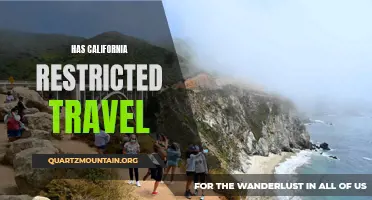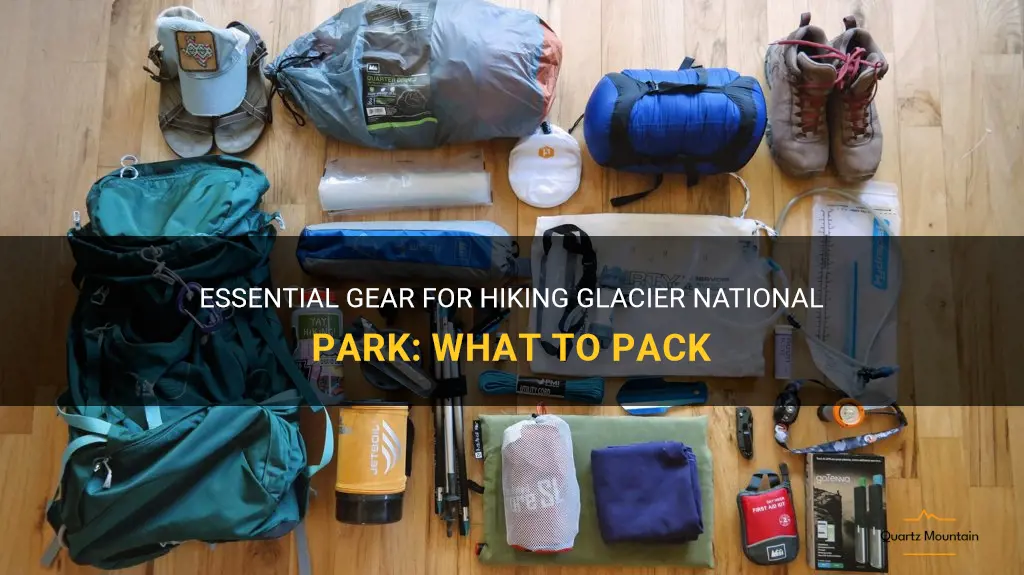
Glacier National Park is a stunning wilderness area located in Montana, known for its breathtaking scenery and pristine natural beauty. Whether you are an experienced hiker or a novice adventurer, exploring this park is an awe-inspiring experience. However, the rugged terrain and unpredictable weather conditions make it essential to pack the right gear for your hike. In this guide, we will explore the essential gear you should pack for hiking in Glacier National Park, ensuring that you are well-prepared for your outdoor adventure. From sturdy hiking boots to waterproof outerwear, we will cover all the necessary items so that you can fully enjoy the beauty of this national treasure. So grab your backpack and let's get packing!
| Characteristics | Values |
|---|---|
| Location | Montana, United States |
| Elevation | 4,000 to 10,000 feet |
| Weather | Variable and can change quickly |
| Temperature | Range from 30°F to 80°F |
| Precipitation | Average yearly rainfall of 21 inches |
| Terrain | Rocky and uneven |
| Trails | Over 700 miles of trails |
| Wildlife | Bears, mountain lions, and other wildlife |
| Water sources | Lakes, rivers, and streams |
| Camping | Multiple campgrounds available |
| Daylight | Long summer days with early sunrise and late sunset |
| Clothing | Layered clothing for changing weather conditions |
| Footwear | Sturdy hiking boots with good traction |
| Backpack | 30-50 liter backpack with plenty of room for essentials |
| Water bottles | 2-3 liters of water per person per day |
| Navigation | Detailed maps and compass |
| Sun protection | Sunscreen, hat, sunglasses |
| Insect repellent | Mosquito repellent |
| First aid kit | Basic first aid supplies |
| Food | Lightweight, high-energy snacks |
| Bear spray | Bear spray for bear encounters |
| Camera | Camera or smartphone for capturing the stunning scenery |
| Personal items | ID, credit cards, cash, cell phone, etc. |
| Emergency | Emergency whistle, flashlight, and extra batteries |
| Camping gear | Tent, sleeping bag, sleeping pad, cooking supplies, etc. |
| Personal hygiene | Toiletries, toilet paper, hand sanitizer |
| Trash bags | Lined bags for carrying out trash |
| Leave No Trace | Knowledge and commitment to leave no trace on the trails |
What You'll Learn
- What are the essential items to pack for a hiking trip in Glacier National Park?
- Are there any specific clothing or gear recommendations for hiking in Glacier National Park?
- How should I prepare for the unpredictable weather conditions in Glacier National Park?
- Are there any food and water considerations I should keep in mind when packing for a hiking trip in Glacier National Park?
- Are there any safety precautions or emergency items that are especially important to bring when hiking in Glacier National Park?

What are the essential items to pack for a hiking trip in Glacier National Park?
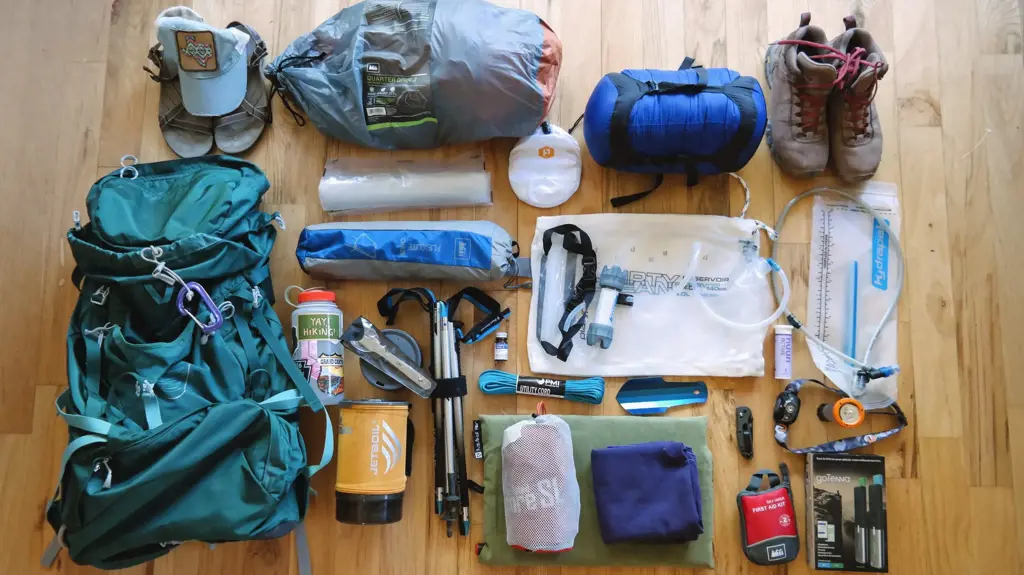
Glacier National Park is a hiker's paradise, with its stunning landscapes, diverse wildlife, and challenging trails. However, it's important to come prepared for a hiking trip in this majestic park. Here are the essential items you should pack to ensure a safe and enjoyable adventure:
- Proper footwear: Invest in a good pair of hiking boots that provide ankle support and have a durable sole for traction on slippery or uneven terrain. It's essential to break in your boots before the trip to avoid blisters and discomfort.
- Layered clothing: Glacier National Park is known for its unpredictable weather, even in the summer months. Pack several layers of clothing, including a moisture-wicking base layer, insulating mid-layer, and a windproof and waterproof outer layer. This will allow you to add or remove layers as needed to stay comfortable throughout your hike.
- Navigation tools: Make sure to carry a detailed map of the park and a reliable compass or GPS device. While the park is well-marked, having these tools can help you stay on the right path and navigate in case of unexpected circumstances.
- Sun protection: Glacier National Park receives intense sunlight, especially at higher elevations. Pack a wide-brimmed hat, sunglasses, and sunscreen with a high SPF rating to protect your skin from harmful UV rays. Don't forget to apply sunscreen regularly, even if it's cloudy.
- Backpack: Choose a comfortable backpack with padded shoulder straps and a waist belt. This will help distribute the weight of your gear evenly and reduce strain on your back. Pack essentials like snacks, water, extra clothing layers, a first aid kit, and a small emergency shelter in case of unforeseen circumstances.
- Water and food: Stay hydrated by carrying an adequate supply of water. The park's water sources may contain harmful bacteria or parasites, so it's best to bring a water filter or purification tablets. Pack nutrient-rich, lightweight snacks and meals that can sustain you during long hikes, such as energy bars, dried fruits, and trail mix.
- First aid kit: Prepare a compact first aid kit with essentials like bandages, antiseptic wipes, pain relievers, blister treatment, and any necessary prescription medications. It's also wise to have knowledge of basic first aid techniques before embarking on your hiking trip.
- Insect repellent: Glacier National Park is home to numerous insects, including mosquitoes and ticks. Protect yourself from bites by applying insect repellent containing DEET or using clothing treated with insect repellent.
- Illumination: Carry a headlamp or a flashlight with spare batteries to navigate in low-light conditions or in case of unexpected delays. It's essential to be prepared for hiking during dusk or dark hours, especially on longer trails.
- Severe weather gear: Glacier National Park experiences sudden weather changes, and it's important to be prepared for rain, snow, or extreme cold. Carry a lightweight rain jacket, a warm hat, gloves, and extra insulation layers in case of unexpected weather shifts.
Remember, preparation is key to a successful and safe hiking trip in Glacier National Park. It's crucial to research trail conditions, check weather forecasts, and inform someone of your hiking plans before heading out. By packing the essential items mentioned above, you'll be well-prepared to enjoy the beauty and challenge of this iconic national park.
Essential Items to Pack for Your Allure of the Seas Cruise
You may want to see also

Are there any specific clothing or gear recommendations for hiking in Glacier National Park?
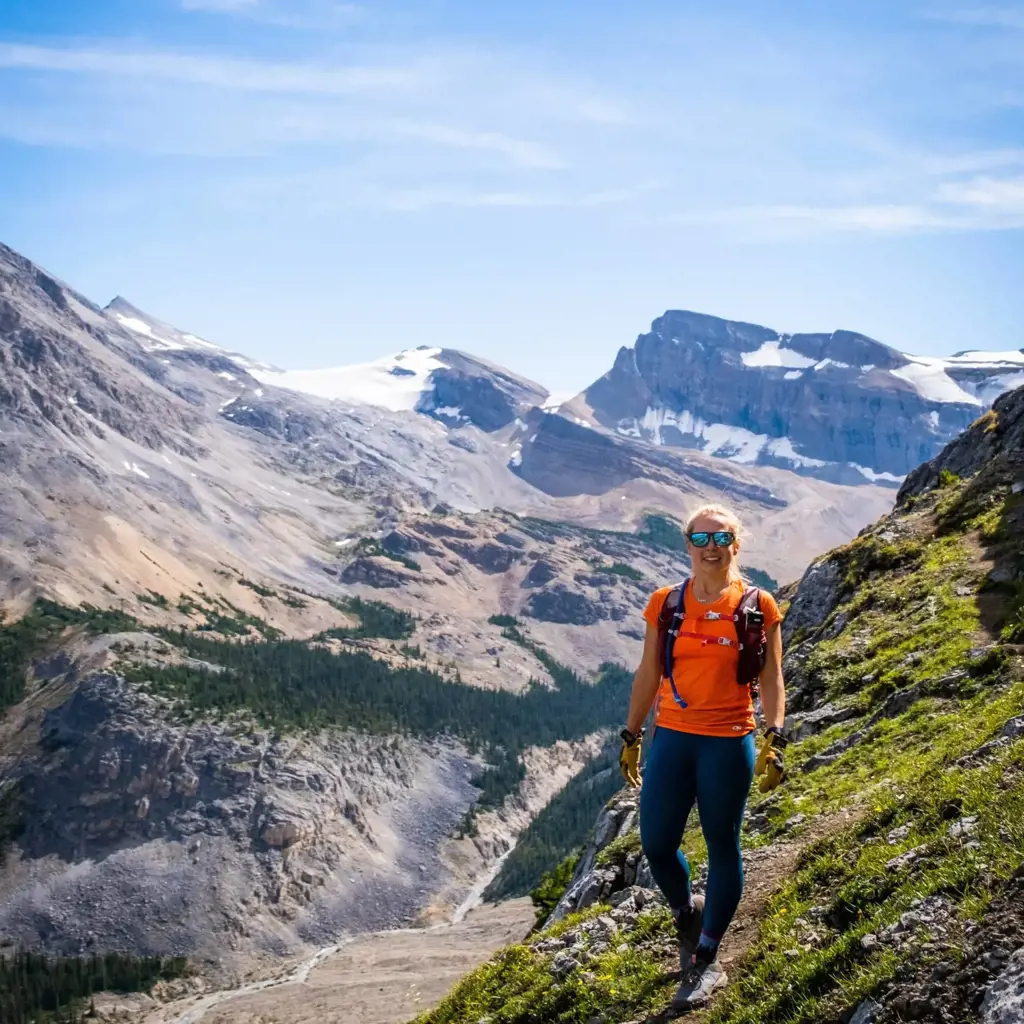
Glacier National Park, located in beautiful Montana, offers some of the most breathtaking and challenging hiking trails in the country. However, due to the park's rugged terrain and unpredictable weather conditions, it's essential to pack the right clothing and gear to ensure a safe and enjoyable hiking experience. Whether you're planning a day hike or a multi-day trek, here are some specific recommendations to consider.
Layered Clothing:
The weather in Glacier National Park can vary greatly throughout the day, even during the summer months. It's crucial to dress in layers that can be added or removed as needed to regulate your body temperature. Start with a moisture-wicking base layer to keep you dry and comfortable. Consider wool or synthetic materials that will still insulate when wet. Add a lightweight, breathable mid-layer for insulation, such as a fleece or down jacket. Finally, top it off with a waterproof and windproof outer layer, such as a rain jacket and pants, to protect you from sudden rain showers or strong winds.
Sturdy Hiking Boots:
Glacier National Park's trails can be rough, rocky, and uneven. A pair of sturdy, well-fitting hiking boots with good ankle support is essential to prevent sprains or injuries. Opt for waterproof boots for added protection against muddy or wet trails. Break in your boots before your trip to avoid blisters and discomfort during your hike.
Comfortable Socks:
Investing in a few pairs of quality hiking socks can make a world of difference on the trail. Look for moisture-wicking and cushioned socks that provide arch support and prevent friction. Avoid cotton socks, as they tend to absorb moisture and can lead to blisters.
Hiking Pants:
Choose lightweight and quick-drying hiking pants that will allow freedom of movement while protecting your legs from brush and insects. Convertible pants that can be zipped off into shorts are a versatile option, especially during warmer days. Consider pants with built-in UPF sun protection for added safety.
Hat and Sunglasses:
Protecting your face and eyes from the sun is crucial, especially at higher elevations where the UV rays are stronger. Pack a wide-brimmed hat or a hat with a neck flap to shield your face and neck from the sun. Don't forget to bring sunglasses with UV protection to safeguard your eyes from glare and harmful rays.
Backpack and Essentials:
A comfortable and properly fitting backpack is essential for carrying all your hiking essentials. Look for a pack with padded shoulder straps and a waist belt to evenly distribute the weight and prevent discomfort or strain. In your backpack, pack essentials like a map, compass, first aid kit, extra water, snacks, sunscreen, insect repellent, and a headlamp or flashlight for emergencies.
Remember, these recommendations are a starting point, and it's crucial to assess your hiking plans for any specific gear requirements. If you're planning to hike in higher elevations or attempt more challenging trails, additional gear like trekking poles, gaiters, and microspikes may be necessary. It's always a good idea to check with park rangers or experienced hikers for specific advice based on the time of year and the trail you plan to explore.
In conclusion, when hiking in Glacier National Park, it's essential to dress appropriately and pack the right gear to ensure your safety and comfort. Layered clothing, sturdy hiking boots, comfortable socks, hiking pants, sun protection, and a well-equipped backpack are some of the key items to consider. By being prepared and well-equipped, you can fully enjoy the beauty and adventure that Glacier National Park has to offer.
The Essential Packing Guide for Your April Trip to Greece
You may want to see also

How should I prepare for the unpredictable weather conditions in Glacier National Park?

Glacier National Park is known for its stunning landscapes and diverse ecosystems. However, it is also known for its unpredictable weather conditions. Visitors to the park should be prepared for whatever Mother Nature throws their way. Whether you're planning a day hike or a multi-day backpacking trip, it's important to be prepared for anything.
Firstly, it's essential to check the weather forecast before heading out. However, keep in mind that weather conditions can change rapidly in the park, so it's always a good idea to be prepared for unexpected changes. Bring a lightweight, waterproof jacket and a hat to protect yourself from rain and snow. Layer your clothing so that you can add or remove layers depending on the temperature.
Secondly, make sure you have the proper footwear. The trails in Glacier National Park can be rocky and slippery, especially in wet conditions. Invest in a sturdy pair of hiking boots with good traction to prevent accidents and keep your feet dry. It's also a good idea to bring extra pairs of socks in case your feet get wet.
In addition to clothing and footwear, it's important to pack the right gear. Always carry a map and compass, even if you plan on using a GPS device. Technology can fail, but a map and compass will always work. It's also important to bring a headlamp or flashlight in case you end up hiking in low light conditions.
Another important item to pack is a first aid kit. Be sure to include items such as bandages, antiseptic wipes, and bug spray. It's also a good idea to bring any necessary medications with you, such as an EpiPen if you have allergies.
When it comes to food and water, it's important to pack more than you think you'll need. Dehydration is a common problem in the park, especially at higher elevations. Carry a water filter or purification tablets so that you can refill your water bottle from the park's natural water sources.
Lastly, always let someone know your plans before you venture out into the wilderness. Leave a detailed itinerary with a friend or family member, including your planned route and estimated return time. This way, if you do encounter unexpected weather conditions or other difficulties, someone will know to alert park officials.
In conclusion, the unpredictable weather conditions in Glacier National Park require careful preparation. Checking the weather forecast, wearing appropriate clothing and footwear, carrying the right gear, and packing enough food and water are key steps to being prepared. Remember to always let someone know your plans and be prepared for unexpected changes in weather. By following these steps, you can have a safe and enjoyable experience in Glacier National Park, regardless of the weather.
How to Safeguard Your Belongings: Essential Items to Pack for Costa Rica to Prevent Theft
You may want to see also

Are there any food and water considerations I should keep in mind when packing for a hiking trip in Glacier National Park?

Glacier National Park is a beautiful and remote destination that offers stunning landscapes and exciting hiking opportunities. As you prepare for your hiking trip in this national park, it's important to consider your food and water needs to ensure a safe and enjoyable experience. Here are some considerations and tips to help you pack and plan accordingly:
Plan your meals and snacks:
Before heading out on your hiking adventure, take some time to plan your meals and snacks for each day. Consider the duration and intensity of your hikes and choose foods that will provide you with the necessary energy and nutrients. Opt for lightweight and non-perishable items that are easy to pack and prepare on the trail.
Pack enough water:
Staying hydrated is crucial when hiking, especially in a remote and potentially strenuous environment like Glacier National Park. Make sure to pack enough water to last you for the entire duration of your hike. Depending on the length of your trip and your water consumption rate, aim for at least 2 liters of water per person per day. This might mean carrying a heavier backpack, but it's essential for your well-being.
Consider water sources on the trail:
While packing enough water is important, you should also be aware of potential water sources along your hiking route. Glacier National Park has various rivers, streams, and lakes where you can replenish your water supply. However, it's crucial to treat the water before consuming it to avoid any waterborne illnesses. Using a water filter or purifier, or treating the water with chemical disinfectants, such as iodine or chlorine, can help make it safe to drink.
Bring lightweight and nutritious food:
When it comes to food, choose lightweight options that won't weigh you down but still provide the necessary nutrients. Consider packing energy bars, nuts, dried fruits, jerky, and dehydrated meals. These items are easy to carry and require minimal preparation. Ensure your meals are balanced and include a mix of carbohydrates, protein, and healthy fats to fuel your body for the strenuous hikes.
Pack food in sealed and waterproof containers:
It's important to protect your food from moisture and potential wildlife encounters. Use sealed and waterproof containers to store your food, preventing any spoilage or contamination. Hanging your food in a bear-resistant bag or container is also recommended to keep wildlife away and minimize the risk of attracting bears or other animals.
Follow Leave No Trace principles:
As you enjoy the beauty of Glacier National Park, it's crucial to minimize your impact on the environment. Follow the Leave No Trace principles, which includes properly disposing of food waste. Pack out any garbage and food scraps to maintain the cleanliness of the park and prevent wildlife habituation.
Remember to consult the park's regulations and guidelines regarding food storage and water treatment. Glacier National Park is a unique and pristine wilderness, and by being prepared and taking the necessary precautions, you can safely enjoy your hiking trip while minimizing your impact on the environment.
The Ultimate Guide: What to Pack for Iceland
You may want to see also

Are there any safety precautions or emergency items that are especially important to bring when hiking in Glacier National Park?
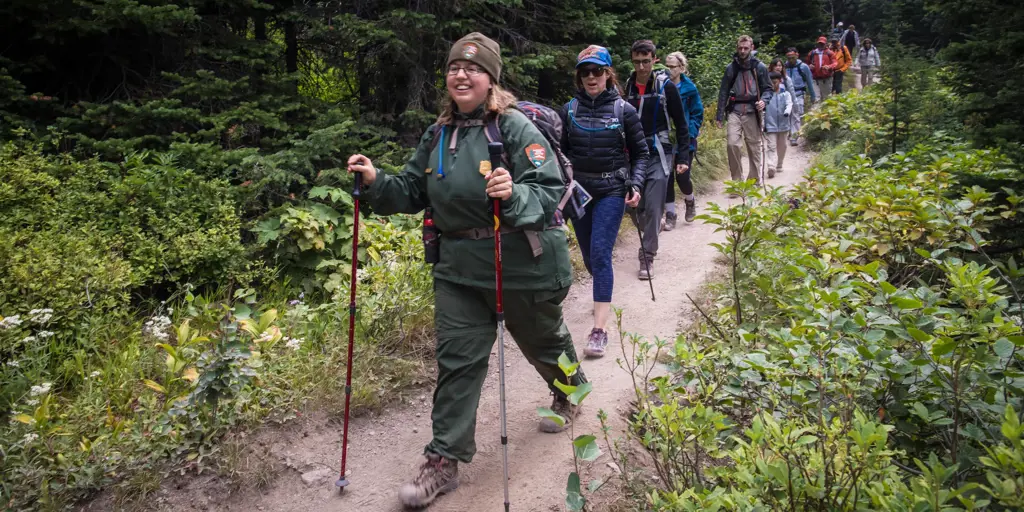
Glacier National Park is a pristine and rugged wilderness area that offers breathtaking landscapes and unforgettable hiking opportunities. However, it is important to be prepared and take safety precautions when venturing into this remote and sometimes challenging environment. While the park provides a unique and exciting experience, it also comes with inherent risks.
One of the most crucial safety precautions to take when hiking in Glacier National Park is to be aware of the weather conditions. The weather in the park can be highly unpredictable, with sudden changes in temperature, storms, and snow possible at any time of the year. Before setting out on a hike, check the forecast and be prepared for any potential weather changes. It is also recommended to start early in the day to avoid afternoon thunderstorms and high winds that are common in the area.
Another essential safety precaution is to bring a map and compass or a GPS device. Glacier National Park has an extensive network of trails, and it is easy to get turned around or lost, especially in unfamiliar areas. Having the ability to navigate using a map and compass or a GPS device can help ensure you stay on the right path and find your way back to safety. Additionally, it is vital to familiarize yourself with the trail you plan to hike and have a general understanding of the park's geography.
Additionally, it is crucial to bring essential safety items such as a first aid kit, enough water, and food. In a remote wilderness area like Glacier National Park, emergency response times can be lengthy, so it is essential to be self-sufficient. A first aid kit should include basic medical supplies such as bandages, antiseptic, and pain relievers. It is also important to carry enough water to stay hydrated throughout the hike, as well as food to maintain energy levels. It is recommended to pack high-energy snacks like trail mix or energy bars.
When hiking in Glacier National Park, it is crucial to wear appropriate clothing and footwear. The terrain can be rough and uneven, and the weather can change rapidly, so it is important to be prepared. Wear sturdy hiking boots that provide ankle support and good traction on various surfaces. Dress in layers to regulate body temperature and be prepared for fluctuating weather conditions. It is also advisable to bring a waterproof and windproof jacket to protect against rain and wind.
Lastly, it is important to inform someone of your hiking plans before entering the park. Let a family member or friend know which trail you plan to hike, your expected return time, and how to contact the park's emergency services in case of an emergency. This information can be crucial in case you fail to return on time or encounter any issues while on the trail.
In conclusion, hiking in Glacier National Park offers an exhilarating experience, but it is essential to take safety precautions. Be aware of the weather conditions, bring navigational tools, carry essential safety items like a first aid kit, water, and food, wear appropriate clothing and footwear, and inform someone of your hiking plans. By following these safety guidelines, you can have a safe and enjoyable experience exploring the beautiful wilderness of Glacier National Park.
Preparing for an Alaskan Summer: What to Pack for the Unpredictable Weather
You may want to see also
Frequently asked questions
For a day hike in Glacier National Park, it is essential to pack a few essential items. These include a backpack to carry your belongings, plenty of water, snacks or a meal, a first aid kit, sunscreen, insect repellent, a map, a compass, a hat, sunglasses, and a light rain jacket or windbreaker. It is also a good idea to wear sturdy hiking boots and comfortable, moisture-wicking clothing.
Yes, there are some specific items you should pack for hiking in Glacier National Park. Since the park is known for its beautiful and diverse wildlife, it is important to carry bear spray for your safety. Additionally, the terrain can be rocky and uneven, so trekking poles can be helpful for stability. Lastly, a camera to capture the stunning scenery and wildlife encounters can also be a valuable addition to your packing list.
Yes, you can bring your dog with you while hiking in Glacier National Park, but there are some important restrictions to keep in mind. Dogs must be kept on a leash that is no longer than six feet at all times. They are not allowed on hiking trails, but they are permitted on paved or gravel roads, in developed areas, and in campgrounds. Be sure to clean up after your dog and dispose of waste in designated receptacles.
When it comes to clothing for hiking in Glacier National Park, it is important to be prepared for changing weather conditions. Layering is key, as temperatures can vary widely throughout the day. Pack moisture-wicking base layers, lightweight and breathable shirts and pants, a warm fleece or insulated jacket, and a waterproof and windproof outer shell. Don't forget to bring a hat, gloves, and warm socks, as well as a swimsuit if you plan to take a dip in one of the park's lakes or rivers.
There are a few items that are not allowed on hiking trails in Glacier National Park. These include bicycles, motorized vehicles, and drones. It is also prohibited to bring any kind of weapon or fireworks into the park. Additionally, to protect the park's natural environment, it is important to leave behind any non-biodegradable items, such as plastic bottles and wrappers. Instead, bring reusable containers and leave no trace of your visit.




